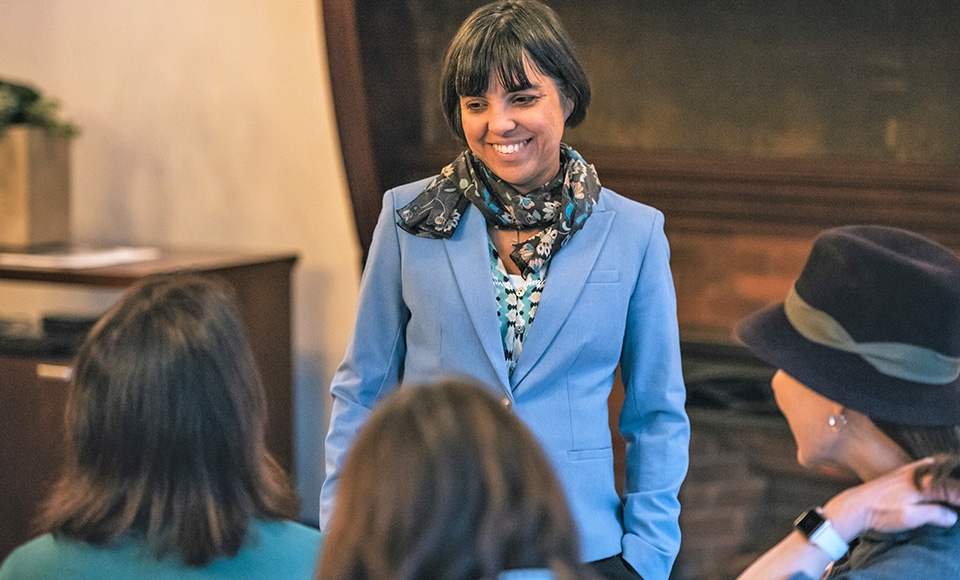Breadcrumbs
- News
- News Archive
- Poetry Prize-Winning Manuscript

Judy Halebsky was visiting with her mom in Falls Church, Virginia when the phone rang. She didn’t recognize the New York phone number but picked up anyway.
“I couldn’t believe it when the man on the phone said he was Billy Collins,” she recalls. Even more surprising was the former U.S. Poet Laureate’s news.
“Billy Collins said that he had read my manuscript, that he loved it, and that he was going to publish it.”
Halebsky’s manuscript was one of three selected by Collins as a finalist for the 2020 Miller Williams Poetry Prize. Spring and Ten Thousand Years (Unabridged) will be published in early March by the University of Arkansas Press, and Halebsky, chair of Dominican’s MFA program and an associate professor of English in the School of Liberal Arts and Education has a series of readings lined up throughout the Bay Area and Sacramento.
Many of the poems in Spring and Ten Thousand Years (Unabridged) are informed by the writings of 17th century Japanese poet Matsuo Bashō, famous for his haiku and poetry journals. Halebsky says the idea for the manuscript came after a period of “intense readings” focused on finding new ways to understand Bashō’s work.
“I was looking at the allusions Bashō made in his work to other writings, while also looking at what his formal influences were,” she says. “So a large part of my book consists of conversations with the poets who shaped Bashō, including Tang dynasty poets Li Bai (also known as Li Po) and Du Fu.”
Asking what would happen if Li Bai and Du Fu —not just their work— appeared in California, the poems explore subjects ranging from work and marriage to environmental destruction. They take the form of conversations between Li Bai, Du Fu, and more poets from the eighth to the 21st centuries, including Grace Paley, the late Donald Hall, and Halebsky herself.
Humor, Halebsky says, is a key thread, as evidenced by titles that include "Li Bai Is Living in a Share house in the Temescal." One poem, for example, tries to explain American culture to someone who has no idea what tech is or a freeway is or a car or gasoline. In another poem, Li Bai considers online dating. Later, he interviews for a job at the Green Gulch Zen Center in Muir Beach.
The University of Arkansas Press describes Spring and a Thousand Years (Unabridged) as an homage to translation. The poems “rely on concepts that can bridge time and space, and as a result, are as likely to find meaning in donuts or Zumba as they are to find it in the ocean. Spring and a Thousand Years (Unabridged) finds reasons for hope not in how the world should be, but in how it has always been.”
As Collins notes in his praise of Spring and Ten Thousand Years (Unabridged): “Halebsky likes the unleashed energy of poetry, and in the poems gathered here, she delivers.”
Halebsky’s previous work includes Tree Line and Sky=Empty, which won the New Issues Prize. Her chapbook Space/Gap/Interval/Distance won the Poets-Under-Forty award from Sixteen Rivers Press. On a MEXT fellowship from the Japanese Ministry of Culture, she trained in Butoh dance at the Ohno Studio in Yokohama and studied Noh theatre at Hosei University in Tokyo. Her translations of poetry from Japanese to English include work by Yuka Tsukagoshi and Mizuho Ishida. More recently, she has published on Canadian poet Roy Kiyooka and global movements in haiku.
Halebsky is among a handful of scholars of Japanese literature to teach haiku at the college level in the United States. She incorporates the study of haiku in many of her courses, including Literature of Nature, Oral and Visual Poetry, and Japanese Literature. Halebsky encourages her students to view haiku as a broader creative practice and creative path.
“I tell my students that people are writing haiku all over the world. It is not a specialist genre, anyone can write a haiku – just like anyone can write a letter. Haiku is more like community-based art.”
Haiku, Halebsky explains, is structured through image rather than a narrative development. Even in the short form, a haiku often offers two images that clash together to evoke a third image. The third image is revealed in the contrast between the two images rather than expressed directly.
“This contrast or juxtaposition is central to the art of haiku. It allows for a space between what is written in the poem and what is evoked by the poem,” Halebsky says.
Much of Halebsky’s work on Spring and a Thousand Years (Unabridged) was done while attending the Community of Writers at Squaw Valley. The setting provided the perfect environment in which to settle into her craft.
“Writing is something that is almost athletic, and you need to spend some time at the track,” she says. “You can get all the best instruction in the world but you need to spend time doing it.”
“No matter the genre, writing is always a creative process focused on trying to get to a synergy. Perhaps poetry is the unconscious mind. Perhaps that’s why you write because the unconscious mind is vastly more complex and interesting than your conscious mind. That’s the real value – to write in a way that’s much more complex than how you can speak.”
Upcoming readings include: